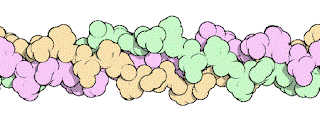All animal, plant and fungal cells are eukaryotes.
Nucleus>
Surrounded by a double membrane called the nuclear envelope.
Contains chromatin, (genetic material).
The control centre of the cell.
Provides instructions for protein synthesis.
 |
| Nucleus |
Nucleolus>
No membrane surrounding it.
Contains RNA. Where ribosomes are made by transcription of ribosomal RNA.
Made up of proteins and ribonucleic acids.
Rough endoplasmic reticulum>
Coated with ribosomes.
A system of membranes.
Translation of proteins.
 |
| RER |
Smooth endoplasmic reticulum>
A system of membranes.
No ribosomes on surface.
Contains enzymes that catalyse reactions involving lipid metabolism.
Synthesis of lipids, steroids and cholesterol.
Golgi apparatus>
Stack of membrane bound flattened sacks.
Modifies and packages proteins.
Creates lysosomes.
Transports lipids around cells.
Mitochondria>
2-5 micrometers long.
Spherical, rod shaped or branched.
Site of ATP production during aerobic respiration.
 |
| Mitochondrion |
Chloroplasts>
Contain loops of DNA and starch grains.
Surrounded by double membrane/envelope.
Site of photosynthesis.
Vacuole>
Surrounded by a membrane called tonoplast and contains fluid.
Important to allow cells to become turgid by osmosis.
Lysosomes>
Small bags formed by golgi apparatus.
Surrounded by single membrane.
Contain powerful, hydrolytic (digestive) enzymes.
Cilia>
Protrusions from the cell, formed of centrioles.
Beat and move mucus in airways.
Cell signalling.
Ribosomes>
Made up of rRNA and proteins.
Made in the nucleolus.
Some attach to RER but some remain free in the cytoplasm.
Protein synthesis.
 |
| Ribosome Translating Protein |
Centrioles>
Consist of 2 bundles of microtubules.
Made of tubulin.
Forms spindle fibres during cell division.
Cytoskeleton>
Cellulose cell wall>
Made of cellulose fibres.
A fibrous tissue.
Provides cell strength and keeps its cell shape.
Permeable


















